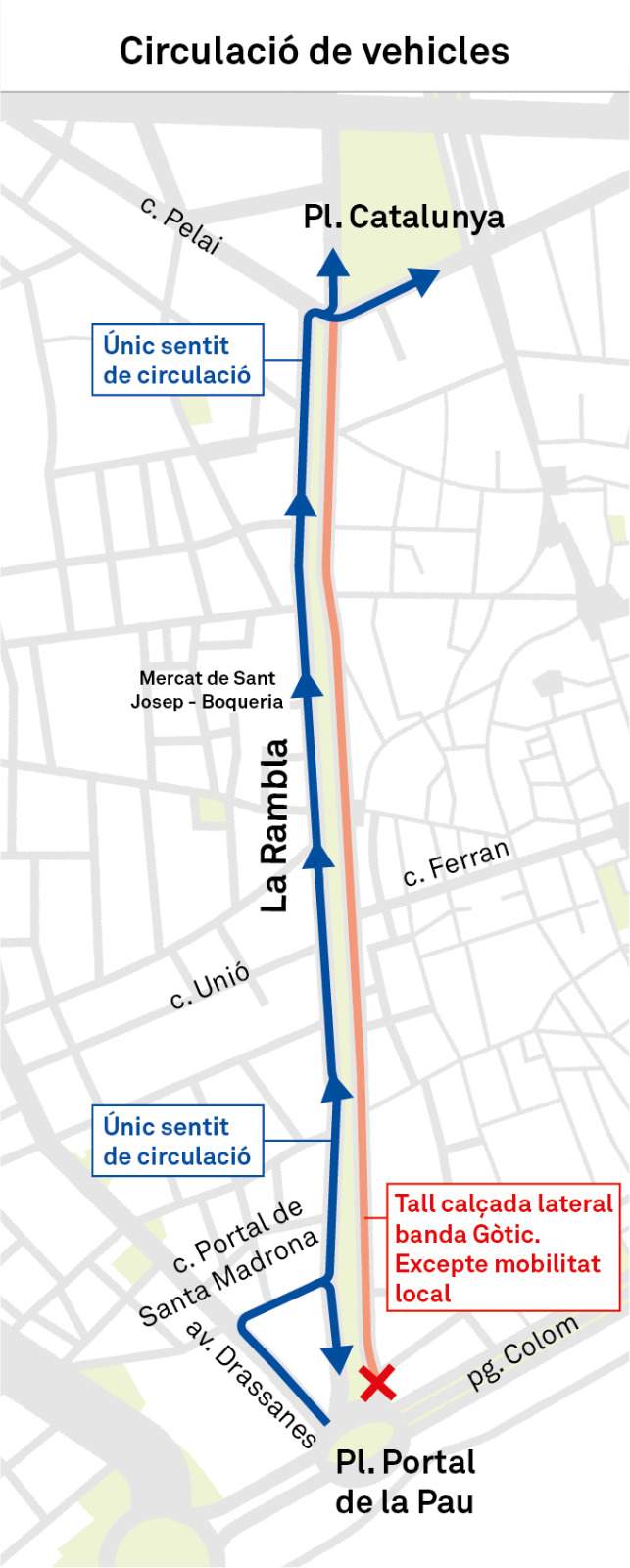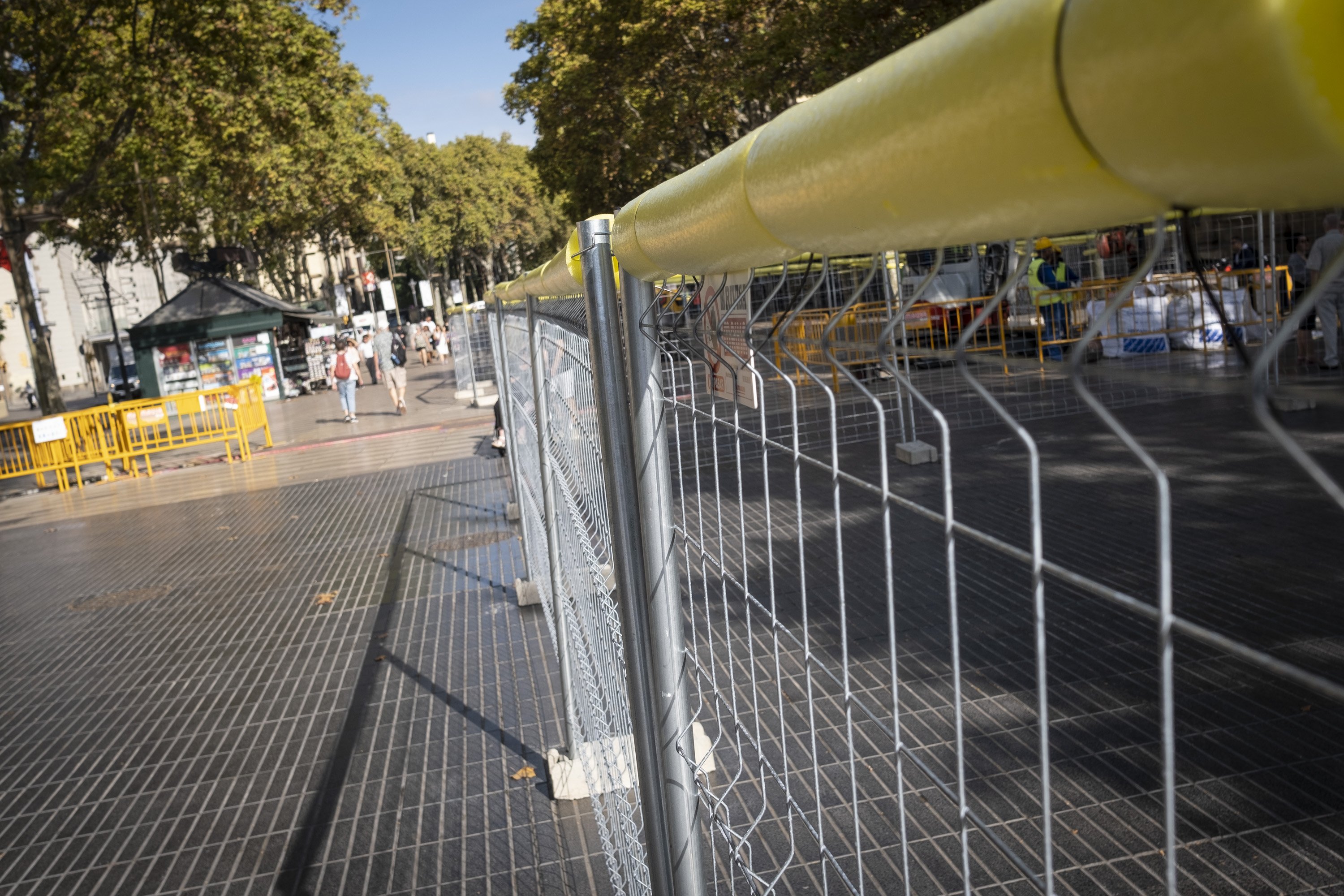The remodelling of La Rambla in Barcelona is about to enter a new phase of reconstruction work that will involve a change in the way the work is organized: instead of the present system, which has just involved one horizontal section of the Rambla - namely, the seaward end of the pedestrian avenue between the portals of La Pau and Santa Madrona, already nearing completion - a new work process based on vertical strips, that is to say, first, working along the whole length of the traffic lane and sidewalk on the Barri Gòtic (Gothic Quarter) side of the avenue, later the same for the El Raval side and, finally, the central promenade. This new way of working intends to reduce the initially planned 72 months of reconstruction to 32 months, based on the desire expressed by the municipal government to speed up the work, with the aim of completing it in February 2027.
In this new context, from this Tuesday, May 28th, preliminary work will begin on changes to guarantee mobility, with the aim that on June 17th the work will effectively begin along the entire length of the sidewalk and roadway on the side facing the Gothic Quarter, which will last for 10 months, that is, until mid-April 2025. The impact on this entire segment of the Rambla will lead to significant changes in mobility, the first of which will mean the temporary elimination of "downhill" traffic, from Carrer Pelai/Plaça Catalunya to the sea, which will be eliminated, at least, until February 2026, the time when both of the lateral strips of the Ramble will have been rebuilt and the work on the promenade will begin.

With the elimination of seaward traffic, which until now has not been restricted at all, it will be possible to divert all traffic in the upward direction, which will continue under the same restrictions as at present: only permitted for service vehicles to load and unload, local residents and car park users, as well as emergency services. Thus, with traffic in only one direction, the entire length of the Barri Gòtic traffic lane will be freed, and that is where the works will be tackled first, in sections of around fifty metres at a time, always ensuring access to emergency vehicles on this side of the Rambla as well.
Traffic lights in the middle of the Rambla
However, there is, of course, a catch or two to this cunning plan. Well, five, actually. To guarantee goods loading and unloading in the Barri Gòtic, with many major commercial areas such as Portal de l'Àngel, Carrer Ferran and Plaça Reial, which all need their exit routes, five temporary sets of traffic lights will be installed on the Rambla, interrupting pedestrian movement to allow vehicles - in principle, only those for loading and unloading and for residents - to cross the central promenade from Barri Gòtic to take the ascending lane on the Raval side. These five crossing points will be controlled by traffic lights and the installation of the so-called New Jersey concrete blocks to make the new movement restrictions on Barcelona's quintessential pedestrian promenade more obvious.
The five crossing points will be, from top to bottom: at the intersection with Portaferrisa; on the Pla de la Boqueria - a little above the Joan Miró mosaic; at the intersection with Carrer Ferran; at the entrance to Plaça Reial; and at Carrer Escudellers. Three of them will become operational on the same day, June 17th (Portaferrisa, Ferran and Escudellers), while the others will enter into service later. In any case, Barcelona City Council has recalled that historically these vehicles crossings have existed at some points and that, in any case, they will be temporary, to be removed once the Rambla traffic lanes are back in service in both directions. But what is clear is that, for a while, La Rambla will have traffic lights in the central promenade and the movement of pedestrians will be interrupted by the passage of trucks.
The first deputy mayor, Laia Bonet, has referred to this work as a "transcendental and unique transformation" and asserted that the planning has been done in order to "guarantee mobility". "Part of the success begins with the management of the construction work and the subsequent effects and we want to do it well", said Bonet, who stated that the decision to plan the works in "sections limited to fifty metres" will serve to guarantee the loading and unloading services as well as access for emergency services. In terms of public transport, bus lines 59 and N9 will be affected, which will only go up the Rambla, and for their seaward legs will take Via Laietana, and the V13, which will have start and finish in Plaça Catalunya instead of Pla de Palau as at present.
In any case, all these actions will speed up the reconstruction allow it to finish before the next municipal elections, in May 2027, with a budget of 44 million euros and with an execution time of 32 months. As for the current Phase 1, between the La Pau and Santa Madrona portals, that will be completed during the month of June, with the exception of the Drassanes area and the Santa Madrona portal, which will be completed in July. In time, in any case, to have the seaward end of the Rambla finished before the start of the America's Cup yachting, in August.

